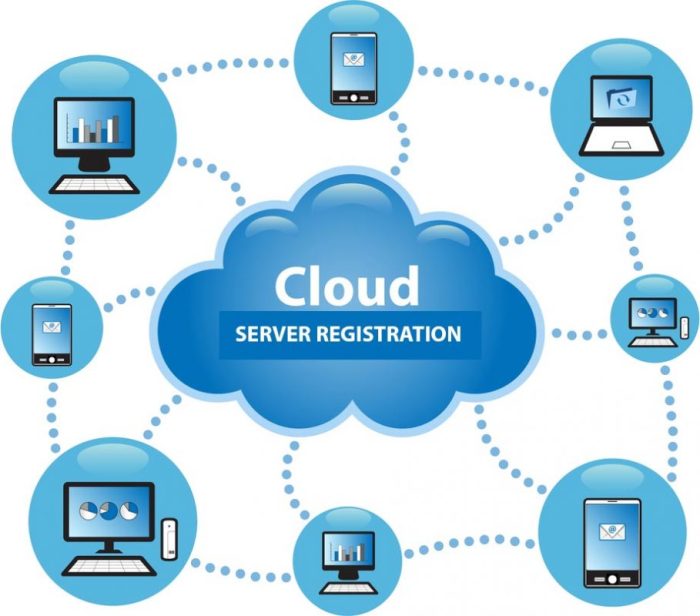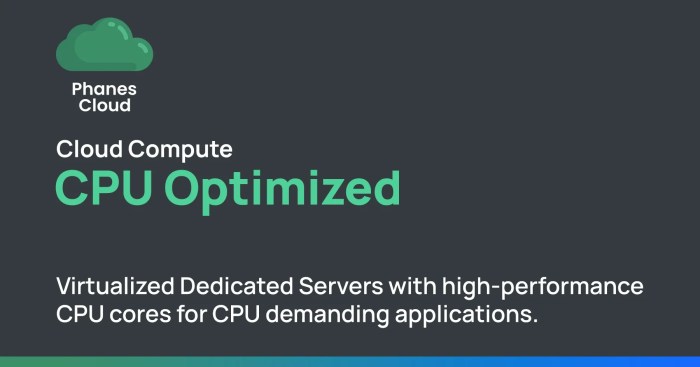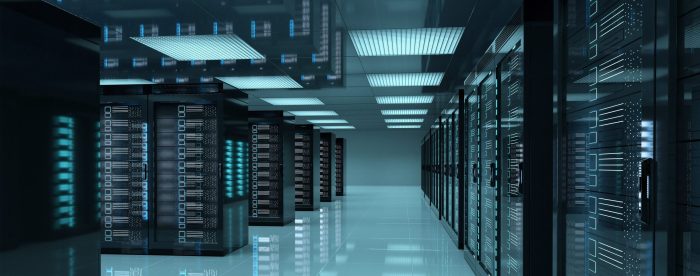Cloud cpu server – Cloud CPU servers: They’re the unsung heroes of the digital world, powering everything from your favorite streaming service to that cat video that went viral. But what exactly
-are* they? Think of them as the brains of the operation, the processing power behind countless applications and websites. This deep dive will explore the architecture, selection process, security, and optimization of these essential components of the cloud computing landscape.
We’ll cover everything from choosing the right server for your needs to keeping it running smoothly and securely, so you can focus on what really matters – building awesome stuff.
We’ll unpack the differences between virtual and dedicated servers, explore various performance characteristics (like burstable vs. sustained), and even take a peek under the hood at different CPU architectures. We’ll also tackle the crucial aspects of security and cost optimization, providing practical tips and best practices to help you navigate the world of cloud computing with confidence. Get ready to level up your cloud knowledge!
Defining Cloud CPU Servers

Cloud CPU servers, also known as virtual machines (VMs) or compute instances, are the fundamental building blocks of cloud computing. They provide on-demand access to processing power, allowing users to run applications and workloads without managing the underlying physical hardware. Think of them as renting a computer, but instead of a physical machine sitting on your desk, it exists in a massive data center somewhere, accessible via the internet.
Core Components of a Cloud CPU Server
A cloud CPU server comprises several key components working together. These include the central processing unit (CPU), which executes instructions; RAM (Random Access Memory), which provides temporary storage for active processes; storage, either local or network-attached, for persistent data; and a network interface for communication with other systems. The operating system (OS), like Windows or Linux, manages these resources, providing a platform for applications to run.
The specific configuration of these components (CPU cores, RAM amount, storage capacity, network bandwidth) varies greatly depending on the instance type chosen.
Virtual vs. Dedicated Cloud CPU Servers
The primary distinction lies in resource allocation. Virtual servers share underlying physical hardware with other VMs, while dedicated servers have exclusive access to a physical machine. Virtual servers are generally more cost-effective for smaller workloads or applications that don’t require consistent high performance, while dedicated servers offer superior performance, isolation, and security, making them suitable for demanding applications or sensitive data.
Think of it like sharing an apartment (virtual) versus renting a whole house (dedicated).
Performance Characteristics of Cloud CPU Server Types
Cloud providers offer a variety of server instance types optimized for different needs. Burstable performance instances offer a baseline CPU allocation with the ability to “burst” to higher levels for short periods, ideal for workloads with sporadic peak demands. Sustained performance instances provide a consistent level of CPU power throughout their operation, better suited for applications requiring steady, predictable performance.
Choosing the right instance type is crucial for optimizing cost and performance. For example, a web server with occasional traffic spikes might benefit from a burstable instance, whereas a database server needs a sustained performance instance.
Examples of Cloud Providers and CPU Server Instances
Several major cloud providers offer a wide array of CPU server instances. The table below provides a small sample; each provider has many more options with varying specifications and pricing. Note that pricing is highly variable and depends on factors like region, usage, and chosen options.
| Provider | Instance Type | CPU Cores | Pricing Model |
|---|---|---|---|
| Amazon Web Services (AWS) | t2.micro | 1 | Pay-as-you-go |
| Microsoft Azure | Standard_B2s | 2 | Pay-as-you-go |
| Google Cloud Platform (GCP) | e2-medium | 2 | Pay-as-you-go |
| Oracle Cloud Infrastructure (OCI) | VM.Standard.E2.1.Micro | 1 | Pay-as-you-go |
Choosing the Right Cloud CPU Server

Picking the perfect cloud CPU server can feel like navigating a maze, but with a little know-how, you can find the ideal fit for your needs. Choosing the wrong server can lead to wasted resources and a hefty bill, while choosing the right one ensures optimal performance and cost-effectiveness. This section will walk you through the key considerations and steps involved in making an informed decision.
Factors Influencing Cloud CPU Server Selection
Several critical factors influence the selection of a cloud CPU server. These factors need to be carefully weighed against each other to find the optimal balance of performance, cost, and scalability. Ignoring any of these can lead to significant problems down the line.
- Workload Requirements: Understanding the computational demands of your application is paramount. Factors like the number of concurrent users, the complexity of your application’s algorithms, and the amount of data processing required will dictate the CPU power, memory, and storage needed. A simple website will have vastly different requirements than a high-performance computing (HPC) application.
- Budget: Cloud computing offers a pay-as-you-go model, but costs can still quickly escalate if you’re not careful. Establish a clear budget and explore different pricing models offered by cloud providers (e.g., on-demand, reserved instances, spot instances) to optimize costs. Remember to factor in not only the CPU costs but also storage, networking, and other related expenses.
- Scalability: Your application’s future needs should also be considered. Choose a cloud provider and server configuration that allows you to easily scale your resources up or down as your application’s demands change. This flexibility is a key advantage of cloud computing and allows you to adapt to unexpected growth or seasonal fluctuations.
- Operating System and Software Compatibility: Ensure the chosen server supports the operating system and software your application requires. Most cloud providers offer a wide range of operating system images, but compatibility should always be verified.
Best Practices for Right-Sizing Cloud CPU Servers
Right-sizing is crucial for maximizing performance while minimizing costs. Over-provisioning leads to wasted resources and unnecessary expenses, while under-provisioning can result in performance bottlenecks and a poor user experience.
- Monitor Resource Utilization: Regularly monitor CPU utilization, memory usage, and disk I/O to identify any bottlenecks or inefficiencies. Cloud providers offer robust monitoring tools to help with this process.
- Start Small and Scale Up Gradually: Begin with a smaller server instance and gradually increase resources as needed. This allows you to optimize costs while ensuring adequate performance.
- Utilize Auto-Scaling: Leverage cloud provider’s auto-scaling features to automatically adjust resources based on real-time demand. This ensures optimal performance while automatically managing costs.
- Consider Reserved Instances or Committed Use Discounts: For long-term, predictable workloads, explore reserved instances or committed use discounts to reduce costs significantly. These options offer substantial price reductions in exchange for committing to a specific instance type and duration.
Step-by-Step Guide for Choosing a Cloud CPU Server
Selecting the right server involves a methodical approach. Following these steps will help you make an informed decision.
- Define Application Requirements: Determine the CPU, memory, storage, and networking needs of your application. Consider peak and average usage.
- Evaluate Cloud Provider Options: Compare the offerings of different cloud providers (AWS, Azure, GCP, etc.) based on pricing, features, and geographic location.
- Select Instance Type: Choose an instance type that meets your application’s requirements and fits within your budget. Consider factors like CPU cores, memory, storage, and networking capabilities.
- Configure Server Settings: Select the operating system, storage type, and networking configuration that are appropriate for your application.
- Test and Monitor: Deploy your application on the chosen server and monitor its performance. Adjust resources as needed based on monitoring data.
Examples of Appropriate CPU Server Types
Different applications require different server types.
- Web Servers for a small blog: A small, low-cost instance with limited CPU and memory would suffice. Think a t2.micro or similar offering from AWS or comparable options from other providers.
- High-traffic e-commerce website: A larger instance with multiple CPU cores, substantial memory, and high network bandwidth would be necessary to handle the traffic load. A c5 instance family from AWS or its equivalent from other providers would be a good starting point.
- Data analytics application: A server with high CPU power and ample memory would be needed for processing large datasets. Consider using a compute-optimized instance type with many cores and large memory, such as an r5 instance family from AWS or its equivalent.
- Machine learning model training: Specialized instances with GPUs (graphics processing units) would be ideal for accelerating the training process. Cloud providers offer various GPU-enabled instances designed for machine learning workloads.
Security Considerations for Cloud CPU Servers

Okay, so you’ve got your cloud CPU server all set up – awesome! But before you start uploading your cat videos and conquering the world of online gaming, let’s talk security. Because, let’s be real, nobody wants their precious data (or their cat videos) to get compromised. Think of security as the ultimate insurance policy for your digital lifeblood.
Cloud CPU servers, while incredibly convenient and powerful, introduce a whole new set of security challenges. Unlike a server you manage in-house, you’re sharing responsibility for security with your cloud provider. Understanding those shared responsibilities, and knowing how to bolster your own security measures, is crucial. This isn’t just about avoiding a minor inconvenience; we’re talking about preventing data breaches, financial losses, and reputational damage.
In this topic, you find that cloud computing server usage is very useful.
Common Security Threats
Cloud CPU servers face a variety of threats, ranging from simple misconfigurations to sophisticated attacks. These include denial-of-service (DoS) attacks, which flood the server with traffic, rendering it inaccessible. Data breaches, resulting from unauthorized access to sensitive information, are a major concern. Malware infections can compromise the server’s integrity and functionality. Insider threats, stemming from malicious or negligent employees, also pose a significant risk.
Finally, vulnerabilities in the server’s software or operating system can be exploited by attackers. Think of it like a house – even the strongest walls are vulnerable if the doors and windows are unlocked.
Best Practices for Securing Cloud CPU Servers
Securing your cloud CPU server involves a multi-layered approach. It’s not a one-size-fits-all solution; it requires a tailored strategy based on your specific needs and risk tolerance. But some best practices apply across the board.
- Access Control: Implement strong password policies, use multi-factor authentication (MFA), and adhere to the principle of least privilege (granting users only the access they need). Think of this as having a super secure door lock with multiple keys, and only giving out keys to people who absolutely need access.
- Encryption: Encrypt data both in transit (using HTTPS) and at rest (using encryption tools like BitLocker or VeraCrypt). This ensures that even if data is intercepted, it remains unreadable. It’s like putting your valuables in a safe – even if someone breaks in, they can’t access the contents.
- Patching: Regularly update your server’s operating system and applications with security patches. This closes vulnerabilities that attackers could exploit. Think of this as regularly maintaining your home security system to protect against new threats.
- Network Security: Use firewalls to control network traffic and prevent unauthorized access. This is like having a security guard at the entrance of your house, checking who comes in and out.
- Regular Security Audits: Conduct regular security audits to identify and address vulnerabilities. This is like a regular home inspection, catching problems before they become big issues.
Comparison of Security Measures
Different cloud providers offer varying levels of security features. Some providers offer managed security services, handling many security tasks for you. Others provide basic security tools that you must configure and manage yourself. The best approach depends on your technical expertise, budget, and risk tolerance. Think of it like choosing between a fully managed security system versus DIY security.
One offers convenience and expertise, the other allows for greater customization and control.
Security Checklist for Deploying a Cloud CPU Server
Before launching your cloud CPU server, it’s essential to have a thorough security checklist. This ensures you don’t miss any crucial steps.
- Enable strong passwords and MFA.
- Configure firewalls and network security groups.
- Encrypt data in transit and at rest.
- Implement regular patching and updates.
- Establish a robust access control policy.
- Conduct regular security audits and penetration testing.
- Monitor server logs for suspicious activity.
- Establish an incident response plan.
Managing and Monitoring Cloud CPU Servers
Keeping your cloud CPU servers humming along requires a proactive approach to management and monitoring. Think of it like maintaining a high-performance sports car – regular checkups and adjustments are crucial to prevent breakdowns and maximize performance. Ignoring these aspects can lead to slowdowns, downtime, and ultimately, higher costs. This section covers key strategies for ensuring your cloud servers remain efficient and reliable.
Monitoring Cloud CPU Server Performance
Effective monitoring provides real-time insights into your server’s health and performance. This allows for early detection of potential issues before they impact your applications or users. Key metrics to track include CPU utilization, memory usage, disk I/O, and network traffic. Most cloud providers offer built-in monitoring tools, providing dashboards and alerts based on predefined thresholds. These tools often allow you to visualize resource consumption over time, identifying trends and potential bottlenecks.
For example, Amazon Web Services (AWS) offers CloudWatch, which provides detailed metrics and allows you to set up custom alarms based on specific thresholds. If CPU utilization consistently exceeds 80% for extended periods, it signals a need for investigation and potential scaling up of resources. Similarly, high memory usage could indicate memory leaks in your applications, requiring code optimization or increased memory allocation.
Optimizing Cloud CPU Server Performance
Once you’ve identified performance bottlenecks through monitoring, optimization strategies can be implemented. This could involve several approaches, depending on the specific issue. If CPU utilization is consistently high, consider optimizing your application code for efficiency. This might involve using more efficient algorithms, reducing database queries, or implementing caching mechanisms. If memory usage is a concern, identify and address memory leaks in your applications.
Tools like memory profilers can help pinpoint areas where memory is being inefficiently used. Another approach is to right-size your server instances. If you’re consistently underutilizing your resources, downsizing to a smaller instance can reduce costs without sacrificing performance. Conversely, if you frequently hit resource limits, scaling up to a larger instance can improve performance.
Managing Cloud CPU Server Resources Effectively
Effective resource management is about balancing performance with cost. This involves strategically allocating resources to your applications based on their needs. Right-sizing instances is a key component of this. Avoid over-provisioning resources unnecessarily, as this increases costs. Implement auto-scaling features offered by cloud providers.
This allows you to automatically adjust the number of instances based on demand, ensuring optimal performance while minimizing costs. For instance, AWS Auto Scaling automatically adjusts the number of EC2 instances based on metrics such as CPU utilization or request count. Regularly review your resource utilization and adjust your configurations as needed to maintain optimal performance and cost efficiency.
Troubleshooting Common Cloud CPU Server Performance Issues
Troubleshooting often begins with analyzing the monitoring data to pinpoint the root cause. High CPU utilization might indicate a poorly performing application, a resource-intensive process, or a denial-of-service attack. High memory usage might point to memory leaks in your application code or insufficient memory allocation. Slow disk I/O could suggest a need for faster storage or database optimization. Network bottlenecks might require investigation of network configurations and potential bandwidth limitations.
Cloud providers often provide logging and debugging tools to aid in troubleshooting. These tools can provide detailed information about errors, resource usage, and application performance. Understanding the specific error messages and logs is crucial for effective troubleshooting. For example, if you encounter frequent “out of memory” errors, you need to investigate memory usage patterns in your application.
From understanding the core components of a cloud CPU server to mastering cost optimization strategies, this exploration has hopefully illuminated the critical role these powerful engines play in the modern digital world. By carefully considering factors like workload requirements, security protocols, and performance characteristics, you can effectively leverage cloud CPU servers to build scalable, robust, and cost-efficient applications. Remember, the right cloud CPU server is the key to unlocking the full potential of your projects.
So go forth, and build amazing things!
Key Questions Answered: Cloud Cpu Server
What’s the difference between a CPU core and a thread?
A core is a physical processing unit, while a thread is a smaller unit of execution that can run within a core. Hyperthreading allows a single core to handle multiple threads concurrently, increasing processing power.
How do I choose between burstable and sustained performance instances?
Burstable instances offer lower base performance but can burst to higher levels when needed, ideal for less consistent workloads. Sustained performance instances provide consistent high performance, better for applications with constant high demand.
What are spot instances, and are they risky?
Spot instances are spare compute capacity offered at significantly lower prices. They’re great for fault-tolerant applications but can be interrupted with short notice if the provider needs the resources.
What are some common cloud CPU server monitoring tools?
Cloud providers like AWS (CloudWatch), Azure (Azure Monitor), and GCP (Cloud Monitoring) offer robust built-in monitoring tools. Third-party tools like Datadog and Prometheus also provide comprehensive monitoring and alerting capabilities.